The Samsung Galaxy S6 and S6 edge Review
by Joshua Ho on April 17, 2015 9:00 AM EST- Posted in
- Smartphones
- Samsung
- Mobile
- Galaxy S6
- Galaxy S6 Edge
Display
As we briefly discussed in our look at the specifications, the Galaxy S6 line introduces a newer generation of AMOLED displays, which is said to increase maximum luminance to 600 nits. Samsung claims that this was achieved with the use of new materials, which is likely necessary in order to sustain power efficiency improvements. It doesn't seem that AMOLED is uniquely suited to high resolution, but rather that Samsung Display Corp. is managing to dramatically improve how they make AMOLED displays with every year that offset power consumption increases from higher resolution displays.
To find out how Samsung did, we use SpectraCal's CalMAN 5 Ultimate, in addition to X-Rite's i1Pro2 Basic to characterize displays as accurately as possible.
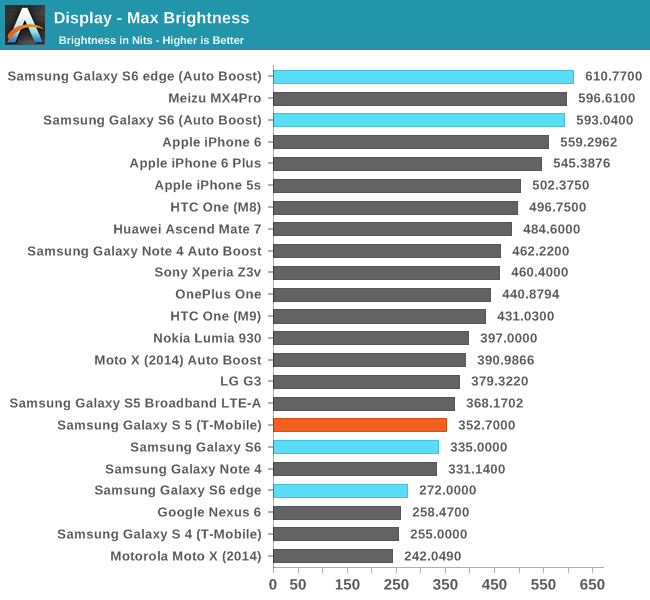
From the results Samsung's claims of a 600 nit display are valid in this case, which is a 100% APL white display. It's important to note that achieving this requires the use of auto-brightness, and that manual brightness is limited to a much lower brightness to reduce power usage, here the S6 sees similar maximum brightness as the S5. The S6 edge disappointingly only achieves 272 nits in this mode, a rather low value. I saw color balance shift dramatically in auto-boost mode, which suggests that this operating mode is likely less efficient than manual brightness. As an explanation, we've seen that colors are controlled in AMOLED by voltage while brightness is controlled by PWM (pulse width modulation). As with most recent AMOLED displays, there's no DC bias to the pixels so the contrast really is infinite instead of just a very large number when displaying black.
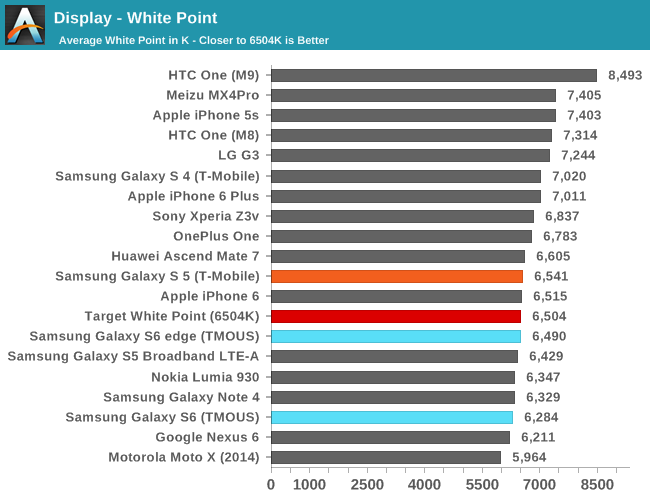

Moving on to grayscale, we can see that Samsung has done a pretty good job of controlling the white point and gamma across the saturation sweep, even if green is slightly dominant in both displays. We can also see that there is variation across displays as the S6 edge is closer to neutral while the S6 sample tends a bit warmer.
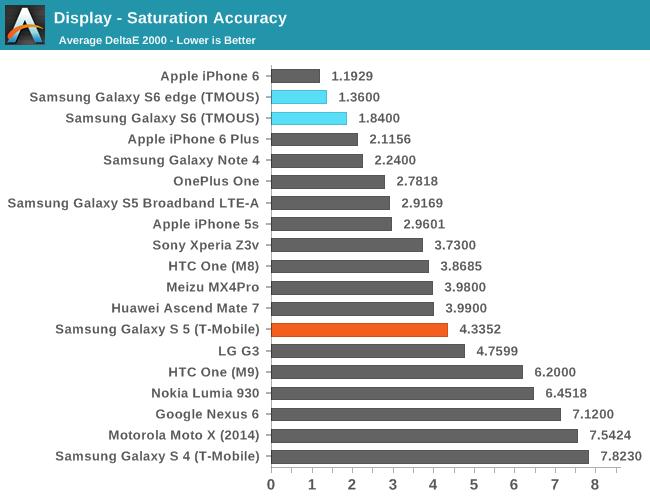
In the saturation sweep, both displays do an incredible job. I really don't have anything else to say here, because there's really no way to improve on the level of calibration Samsung has done on this display. Unless Samsung calibrates every single display in production, which is wildly impractical and effectively impossible to do, this is as good as it gets for a mass-produced device. Improving past this point will also be incredibly difficult to perceive, which means there's no real reason to go any further.
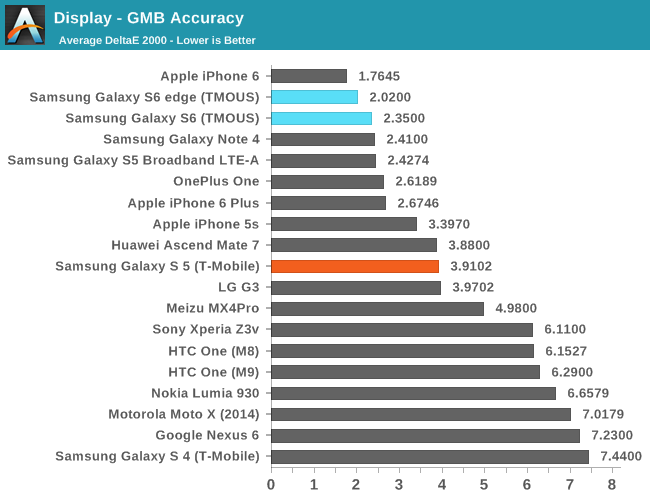
In the Gretag MacBeth ColorChecker, we can get an idea for overall color accuracy, which paints a picture similar to the saturation test. The only real problem I've noticed with these displays are the viewing angles, which can produce color shifting when the display is tilted. This is a bit of an issue on the edge variant as I can see that the edges of the display appear somewhat green when viewed head on, but otherwise there are no real issues to be seen here.
Overall, from a color standpoint it’s looking like Samsung has made one of the best displays available on the market today. Color accuracy is at the point where it’s pretty safe to say that the calibration doesn’t have clear color errors, and the peak brightness of the display is incredibly high. The 1440p resolution helps to compensate for the PenTile subpixel layout so in practice it’s effectively impossible to make out any pixels or the subpixel pattern. The contrast remains infinite as with most modern AMOLED displays, and overall it’s really hard to find any issue with the Galaxy S6’s display at first.
However while the S6 edge seems to be without any issues, the S6 does have some odd display issues that can be seen in direct sunlight as seen in the photo above. To be clear about this the photo above is a simple white screen, which should make the image completely homogeneous but instead there are two visible vertical lines and another jagged horizontal line that appear across the display. Inspection under a light microscope doesn’t really reveal what’s causing this, but the defect is quite visible in practice as seen in the photo above. I suspect that defects are rare, and in any condition other than direct sunlight I can’t see this visual problem.
While trying to see what this kind of defect looked like under a microscope, I also went ahead and took some photos of the subpixel pattern. As far as I can tell, it looks like the green subpixels have a bit more variance than what we’re used to as they tend towards oblong shapes rather than circles, which is likely due to the much tighter pixel density. It seems that this variance may cause some color shifting in certain units, which seems to remain a potential problem with Samsung's AMOLED displays. The pixel fill factor still remains surprisingly low when compared to LCDs, which usually have much higher active area. Due to the subpixel arrangement and some other differences in the display design, color shifting also remains higher than one would expect from LCD displays that are found in phones like the iPhone 6.
The final test that I managed to run on the Galaxy S6 is the brightness vs APL test, which shows the advantage of AMOLED’s emissive nature as it can dynamically increase brightness if the entire display isn’t showing a white screen. As a result, this means that in low APL scenarios like dark movie scenes and app themes it’s possible to see a maximum brightness closer to 700 nits or higher. However, in practice the display’s practical brightness is closer to 600 nits.
Overall, the display is still one of the best on the market, but I would be a bit concerned about fill factor for VR applications as that was a problem on the Note 4. Issues like purple smearing have been resolved, but there are still some problems with the display such as color shifting with changes to viewing angles and some variability in display quality from unit to unit. With this generation I suspect Samsung is either meeting or exceeding the best LCDs in quality, and with the next generation of AMOLED it’s likely that high end smartphones will have to migrate to AMOLED to remain competitive.



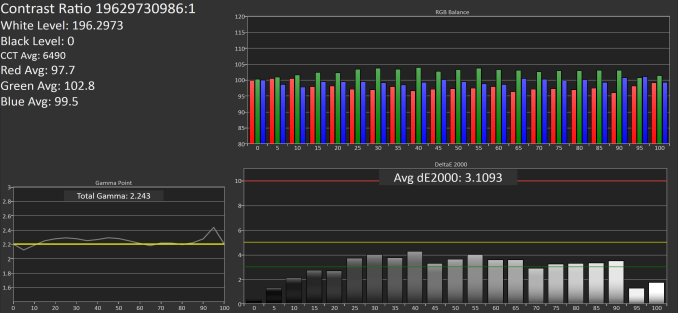
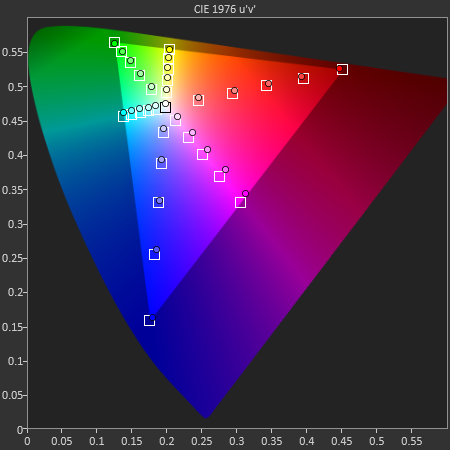
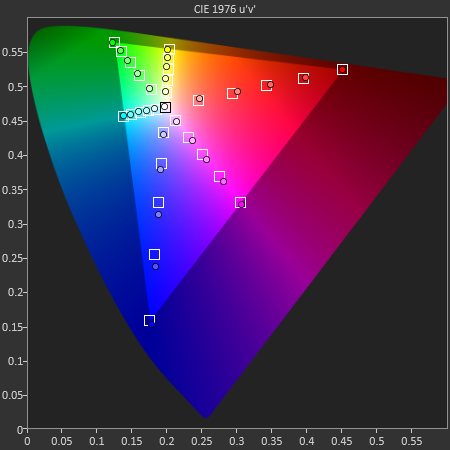
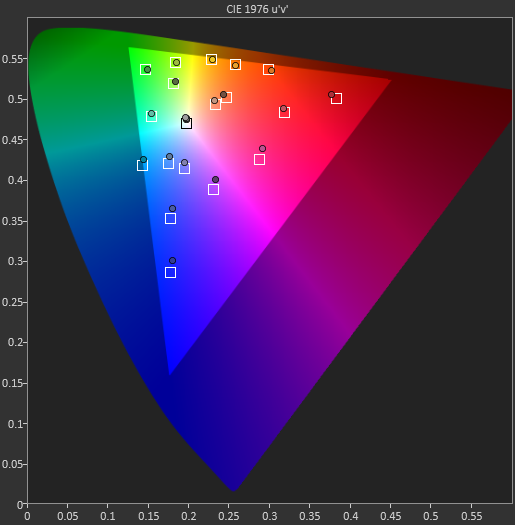

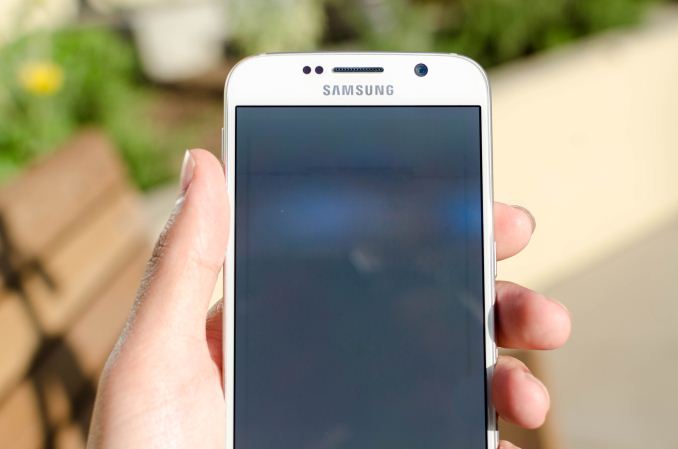
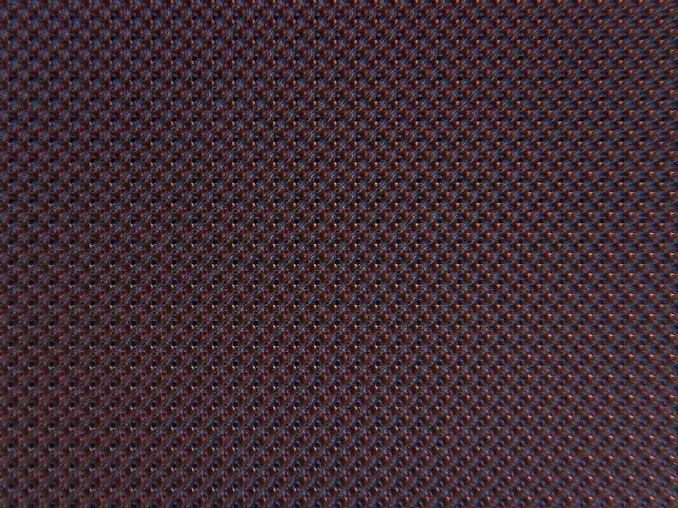
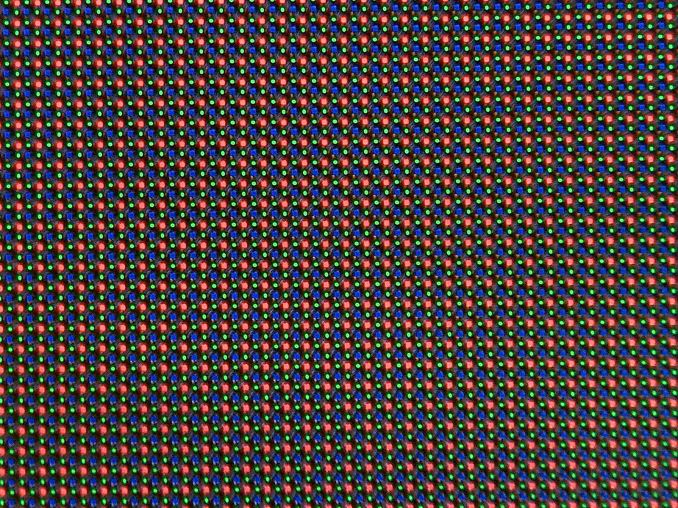
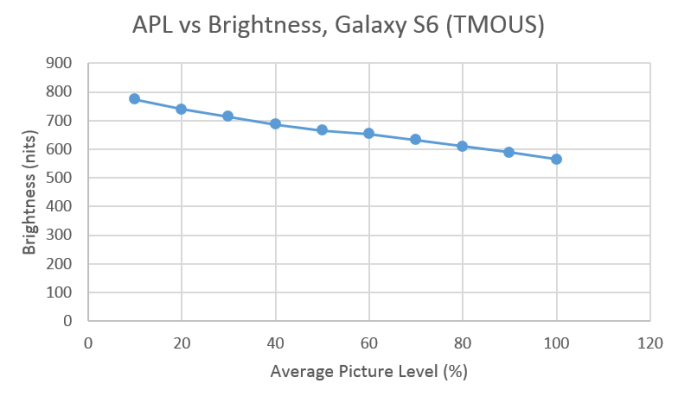








306 Comments
View All Comments
Drumsticks - Friday, April 17, 2015 - link
Thanks for the review! I've been waiting on the Anandtech review before looking at a new phone; y'alls simply can't be beat.The major concern for me with the S6 was battery life, but you seem to have put that concern to rest here. I fall under the "drawn by the new design" camp as well - I'm a pretty heavy user, but removable storage has never really mattered to me as I don't like keeping too much data on my phone. A removable battery is nice, but I'm already used to having a power pack with me so that's not a huge deal. I'm still waiting to see what the LG G4 brings though. If performance is good enough with the rumored SD 808 (really concerned about GPU driving the QuadHD Display), then the larger battery could make it worth it to go to LG. I'm also hoping that Samsung releases a custom theme tool, and somebody makes a relatively close stock Android icon/color set, as the default TouchWiz UI is kind of gaudy for me (teal? seriously?)
soccerballtux - Friday, April 17, 2015 - link
wow, I'm pretty impressed with the low-light performance of the camera.Novacius - Friday, April 17, 2015 - link
The first Android smartphone of recent dates that gets everything right imho. I'm considering buying it, but only when the price drops below 500 euros here.generalako - Friday, April 17, 2015 - link
I'm sorry, but I can't take Anandtech seriously anymore. I mean, just look at the the review of this phone's display. Somehow the iPhone 6 beats it in nearly every aspect, and there are key areas where the S6 is even worse than many other phones (like White Point). Compare this to DisplayMates shootout of the S6 (which is much more broad and of course has more legitimacy), who came to the conclusion that the S6 is the best phone display they have ever tested on almost every aspect. The same conclusion they had with the Note 4. Based on this review, however, the AMOLED on the S6 is still not better than the best LCD phone (iPhone 6).Let me give an example of how much these two tests vary, and how serious you should take Anandtech's test:
DisplayMate: "When Automatic Brightness is turned On, the Galaxy S6 reaches an impressive 784 cd/m2 (nits) "
Anandtech: Samsung Galaxy S6 reaches 610 nits.
That's a whole difference of 174 nits from the two tests!
Andrei Frumusanu - Friday, April 17, 2015 - link
DisplayMate derives that figure from a 1% APL pattern, which is pretty non-representative of any real-world use-case. The 610 nit figure here comes from a 100% APL image, meaning pure white. Also, if you read the bottom part of the display section, you will see the APL chart where we indeed show how brightness increases with lowering APL, reaching near the very figures that you are quoting.magreen - Friday, April 17, 2015 - link
You can't take Anandtech seriously because its data is (arguably) contradicted by one other review site's data?lesbaer45 - Friday, April 17, 2015 - link
As has been said repeatedly for a variety of reasons. No SD, not buying. No removable battery, not buying.I either hang on to the S5 until it dies or buy something else that meets my needs. Plain and simple.
Chaser - Friday, April 17, 2015 - link
Everyone has different phone usage preferences. I have no need for a 64-128GB SD card on top of the native storage. I have modest music stored and although I take a lot of photos I use One Drive's "camera roll" feature that immediately uploads new shots to my cloud when a usable wifi connection is made and they land on my PC in seconds.This removable battery/SD card "must have" mantra is getting old. I have absolutely no interest in carrying around an extra battery. Hopefully as native storage becomes more affordable and batteries even more efficient it will fade away forever.
Shadowmaster625 - Friday, April 17, 2015 - link
Its a shame they had to add all those wasted pixels. This phone would have much bettery performance and battery life at 1080p. I really dont get this need to drive so many pixels. The market needs to start penalizing this stupidity.Novacius - Friday, April 17, 2015 - link
I clearly see a difference because of the pentile matrix. For every green subpixel there are one bigger red and one blue subpixel. So the "effective resolution" is 1/3rd lower, which places the S5 at 288 dpi and the S6 at 384ppi respectively. Where I can see some sort of individual pixels or pentile "grain" on the S5's display, thats nearly impossible with the S6.